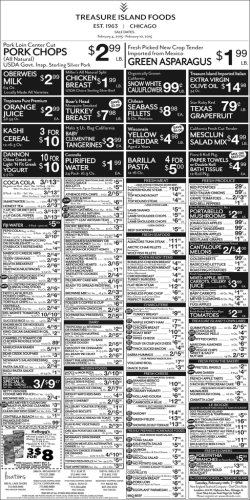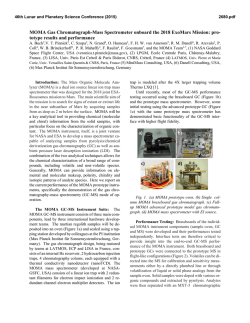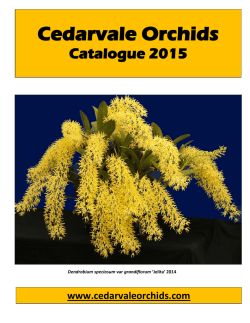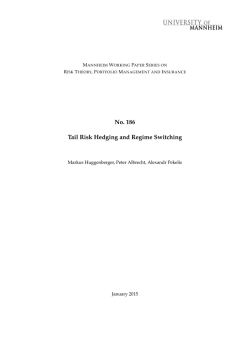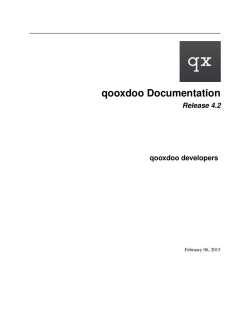
Full-Text (PDF) - Tropical Journal of Pharmaceutical Research
Wei et al Tropical Journal of Pharmaceutical Research January 2015; 14 (1): 149-152 ISSN: 1596-5996 (print); 1596-9827 (electronic) © Pharmacotherapy Group, Faculty of Pharmacy, University of Benin, Benin City, 300001 Nigeria. All rights reserved. Available online at http://www.tjpr.org http://dx.doi.org/10.4314/tjpr.v14i1.21 Original Research Article Gas Chromatographic-Mass Spectrometric Analysis of Essential Oil of Jasminum officinale L var Grandiflorum Flower Feng huan Wei*, Fei long Chen and Xiao mei Tan College of Traditional Chinese Medicine, Southern Medical University, Guangzhou, China, 510515 *For correspondence: Email: [email protected]; Tel: +86 20 61648263; Fax: +86 20 61648244 Received: 8 September 2014 Revised accepted: 12 December 2014 Abstract Purpose: To analyze the essential oil composition of the flower of Jasminum officinale L. var. grandifloroum L. (Jasminum grandiflorum) by gas chromatography-mass spectrometry (GC-MS). o o Methods: The optimum GC-MS conditions used for the analysis were 250 C inlet temperature, 150 C o MSD detector temperature, and GC oven temperature program as follows: 100 C initial temperature, o o o increased to 270 C at 4 C/min, final temperature 270 C and held for 7.5 min. Results: Thirty compounds were identified, representing 99.28 % of the oil content. The major volatile components of the flower were 3,7,11,15- tetramethyl-2-hexadecen-1-ol(phytol) (25.77 %), 3,7,11trimethyldodeca -1,6,10-trien-3-ol (12.54 %) and 3,7,11,15- tetramethyl -1-Hexadecen-3-ol (12.42 %). Conclusion: The results show that phytol is the major volatile component of Jasminum grandiflorum. Keywords: Jasminum grandiflorum, Essential oil, Gas chromatography-mass spectrometry Tropical Journal of Pharmaceutical Research is indexed by Science Citation Index (SciSearch), Scopus, International Pharmaceutical Abstract, Chemical Abstracts, Embase, Index Copernicus, EBSCO, African Index Medicus, JournalSeek, Journal Citation Reports/Science Edition, Directory of Open Access Journals (DOAJ), African Journal Online, Bioline International, Open-J-Gate and Pharmacy Abstracts INTRODUCTION Jasminum officinale L. var. grandiflorum (Jasminum grandiflorum) is one of the Jasminum plants used as a folk remedy for the treatment of hepatitis, dysmenorrhea, stomatitis, duodenitis and depression in south China [1]. There are few reports about its chemical constituents and pharmacological properties, such as the hydroalcoholic extract from the buds of Jasminum grandiflorum showing preferable antiviral efficacy against HBV replication in HepG2 2.2.15 cell line in vitro [2]. Six phenolic compounds have been detected from water-methanol extracts of Jasminum grandiflorum which showed potentials for the treatment of psychiatric disorders and antioxidant protection [3]. Iridoid-type compounds, secoiridoid glucosides, triterpenes, flavonoids, lignans, etc, have also been isolated from this herb [4-6]. Ole (Oleaceae) obtained from the flowers of Jasminum grandiflorum blocked effectively hepatitis B surface antigen secretion in HepG2 2.2.15 cells in a dose-dependent manner (IC50 = 23.2 g mL-1) while 80 mg/kg of Ole also reduced viremia in DHBV-infected ducks [7]. Jasminum grandiflorum is aromatic and an excellent source of essential oils. As far as we know, no works on its essential oil analysis has been reported. The objective of this study, therefore, is to evaluate the chemical composition of the flower oil of this plant by GCMS. Trop J Pharm Res, January 2015; 14(1): 149 Wei et al EXPERIMENTAL Instruments An Agilent 6890N gas chromatography instrument, combined with an Agilent-5973 mass spectrometer equipped with an electron ionization (EI) and quadrupole analyzer, and Agilent Chem Station data system were used. GC separation was performed on a 30m DB-5 ms fused silica capillary column with an internal diameter of 0.25 mm and a film thickness of 0.25µm (Agilent, USA). Materials and chemicals Jasminum grandiflorum (Jasminum officinale L. var. grandifloroum L.) samples (batch no. 201301011, from Heshan City, Guangdong Province, China) were purchased from Guangzhou Kangsheng Pharmaceutical Co, Ltd. All samples were identified by Hongwei Zhang (Associate Professor, Department of Medicinal Plants & Pharmacognosy, Southern Medical University, Guangzhou, China) according to pharmacognostic standard documented in Vol 1, 2004 edition, Guangdong Province Chinese Medicine Standards [8]. All samples were kept in a desiccator (silica gel as desiccant) at room temperature in Department of Chinese Medicine Pharmaceutics, College of Traditional Chinese Medicine, Southern Medical University, Guangzhou, China, until used. Ethyl acetate was analytical-reagent grade and purchased from reagent company (Guangzhou, China). Sample preparation essential oil. The essential oil obtained was stored in a sealed glass tube with a screw cap in a refrigerator at 4 oC until analyzed. Analysis of the essential oil The essential oil of Jasminum grandiflorum was subjected to GC-MS analysis system. The carrier gas was helium (99.99 %) with flow rate of 1.0 o mL/min. Inlet temperature was 250 C and MSD o detector temperature was 150 C. Scan range 30 - 550 amu and scan rate of 2 scans/s were used. The GC oven temperature program was used as follows: 100 oC initial temperature, increased to 270 oC at 4 oC /min, final temperature 270 oC and held for 7.5min. The analysis period was 50 min. The oil was dissolved in 1 mL of ethyl acetate and vortex-mixed for 3 min, and finally, 1 µL was injected using a split technique (0.2:1). Identification of oil components was achieved based on their retention index, and by comparison of their mass spectral fragmentation patterns with those reported in the literature and stored in the MS library (D.02.00.275, version 2.0d). RESULTS The total ion chromatogram was obtained and showed in Fig 1. Thirty compounds were identified representing approximately 99.28 % of the oil (Table 1). There were significant differences between the main components of the essential oil. The major volatile components were phytol (25.77 %), 3,7,11-trimethyldodeca -1,6,10-trien-3-ol (12.54%) and 3,7,11trimethyldodeca-6,10-dien-3-ol (12.42%). Jasminum grandiflorum (1 kg) was hydro-distilled for 3 h in a volatile oil extractor to yield 0.39 % of Fig 1: GC-MS total ion chromatogram of essential oil of the flowers of Jasminum grandiflorum Trop J Pharm Res, January 2015; 14(1): 150 Wei et al Table 1: Composition of the flower essential oil of Jasminum Grandiflorum No. 1 2 3 4 5 6 7 8 9 10 11 12 13 14 15 16 Retention time 8.160 15.516 17.004 19.921 20.199 21.195 22.84 23.021 23.928 24.467 24.698 25.090 25.736 26.465 27.573 29.014 17 18 19 20 21 22 23 24 25 26 27 28 29 30 29.203 29.286 29.695 29.897 30.389 31.515 33.709 35.746 37.757 39.664 41.533 43.358 43.501 45.523 Component Formula Mol wt Benzyl acetate Nerolidol Cedrol Methyl myristate 7-Tetradecene Benzyl benzoate Neophytadiene Perhydrofarnesyl Acetone Phytol acetate Nonadecane Geranyl linalool Methyl palmitate 3,7,11,15- tetramethyl -1-Hexadecen-3-ol Hexadecanoic acid 3,7,11-trimethyl-1,6,10-dodecatrien-3-ol 3,7,11,15-tetramethylhexadecanoic acid ester 9,12,15-octadecatrienoic acid methyl ester Heneicosane Phytol Octadecanoic acid methyl ester 9,12,15-Octadecatrienoic acid Docosane Tricosane Tetracosane Pentacosane Hexacosane Heptacosane Octacosane Squalene Nonacosane C 9H 10O 2 C15H26O C15H26O C15H30O2 C 14H 28 C14H12O2 C20H38 C18H36O C22H42O2 C19H40 C20H34O C17H34O2 C20H40O C16H32O2 C15H26O C21H42O2 150.17 222.20 222.20 242.22 196.22 212.80 278.30 268.28 338.32 268.31 290.26 270.26 296.31 256.24 222.37 326.32 Content (%) 0.33 0.11 0.14 0.75 0.20 4.84 0.23 4.85 0.22 0.14 0.12 1.57 12.42 9.16 12.54 0.60 C19H32O2 C21H44 C20H40O C19H38O2 C18H30O2 C22H46 C23H48 C24H50 C25H52 C26H54 C27H56 C28H58 C30H50 C29H60 292.24 296.34 296.31 298.29 278.23 310.36 324.38 338.39 352.41 366.42 380.44 394.45 410.39 408.47 1.33 3.12 25.77 0.56 4.82 0.25 4.00 0.58 1.51 2.54 1.86 1.26 0.46 3.00 DISCUSSION The data show that phytol is the major essential component of Jasminum grandiflorum, and this component may have some of the pharmacological effects of Jasminum grandiflorum plant itself [1]. It was reported that phytol exhibits anticonvulsant activity by modulating of neurotransmitter systems in piloacarpine-induced seizures and showed antitubercular activity against M. tuberculosis H37Rv strain at 100 mg mL-1 (MIC) [9,10]. Acute administration of phytol exerts an anxiolytic-like effect on mice by producing sedative and anxiolytic activities [11]. Phytol also directly activates peroxisome proliferator-activated receptor α (PPARα) and regulated gene expression involved in lipid metabolism in PPARα-expressing HepG2 hepatocytes [12]. Furthermore, trans-phytol inhibits the biosynthesis of estrogen in human ovarian granulose cells by aromatase (CYP19) [13]. methyl compounds in various concentrations, with the major component being phytol. ACKNOWLEDGEMENT We express our appreciation to Associate Professor Hongwei Zhang for identifying the samples and Xiaohua Ye for oil extraction. The work was supported by Science and Technology Planning Project of Guangdong Province, China (no. 2011B032200003) and Science and Technology Planning Project of Guangzhou, China (no. 2012Y2-00018-4). REFERENCES 1. Nanjing University of Traditional Chinese Medicine. Dictionary of Chinese Materia Medica 2nd ed. Shanghai: Shanghai Science & Technology Press, 2006; p 2476. 2. Zhao GQ, Yin ZF, Liu LY, Mao XX, Su ZH. Anti-hepatitis B Virus Activity of 8-epi-Kingiside in Jasminum CONCLUSION officinale var. grandiflorum. Chinese Herbal Medicines 2013; 1: 53-57. The results reveal that the essential oil of the flower of Jasminum grandiflorum contains thirty 3. Ferreres F, Gross C, Gil-Izquierdo A, Valentãob P, Andrade PB. Assessing Jasminum grandiflorum L. Trop J Pharm Res, January 2015; 14(1): 151 Wei et al authenticity by HPLC-DAD-ESI/MSn and effects on 9. Costa JP, Ferreira PB, De Sousa DP, Jordan J, Freitas physiological enzymes and oxidative species. J RM. Anticonvulsant effect of phytol in a pilocarpine Pharmaceut Biomed 2014; 88: 157–161. model in mice. Neurosci Lett 2012; 523: 115-118. 4. Tanahashi T, Sakai T, Takenaka Y, Nagakura N, Chen CC. Structure glucosides elucidation from Jasminum of two secoiridoid officinale L. var. grandiflorum (L.) Kobuski. Chem Pharm Bull 1999; 47: 1582–1586. 10. Saikia D, Parihar S, Chanda D, Ojha S, Kumar JK, Chanotiya CS, Shanker K, Negi AS. Antitubercular potential of some semisynthetic analogues of phytol. Bioorg Med Chem Lett 2010; 20: 508-512. 11. Costa JP, Oliveira GA de, Almeida AA de, Islam MT, 5. Somanadhan B, Smitt UW, George V, Pushpangadan P, Sousa DP de, Freitas RM de. Anxiolytic-like effects of Rajasekharan S, Duus J, Nyman U, Olsen CE, phytol: Jaroszewski JW. Angiotensin converting enzyme transmission Brain Res 2014; 1547: 34–42. Possible involvement of GABAergic (ACE) inhibitors from Jasminum azoricum and 12. Goto T, Takahashi N, Kato S, Egawa K, Ebisu S, Jasminum grandiflorum. Planta Med 1998; 64: 246– Moriyama T, Fushiki T, Kawada T. Phytol directly 250. activates peroxisome proliferator-activated receptor 6. Sadhu SK, Khan MS, Ohtsuki T, Ishibashi M. Secoiridoid components from Jasminum grandiflorum. Phytochem 2007; 68: 1718–1721. alpha (PPARalpha) and regulates gene expression involved in lipid metabolism in PPARalpha- expressing HepG2 hepatocytes. Biochem Bioph Res 7. Zhao GQ, Yin ZF, Dong JX. Antiviral efficacy against Co 2005; 337: 440-445. hepatitis B virus replication of oleuropein isolated 13. Guo JJ, Yuan Y, Lu DF, Du BW, Xiong L, Shi JG, Yang from Jasminum officinale L. var. grandiflorum. J LJ, Liu WL, Yuan XH, Zhang GL, Wang F. Two Ethnopharmacol 2009; 125: 265–268. natural products, trans-phytol and (22E)-ergosta- 8. Guangdong Provincial Administration of traditional 6,9,22-triene-3β,5α,8α-triol, inhibit the biosynthesis of Chinese Medicine. Guangdong Province Chinese estrogen in human ovarian granulosa cells by medicine standard Vol. I, Guangzhou: Guangdong aromatase (CYP19). Toxicol Appl Pharm 2014; 279: Science & Technology Press, Ltd 2004: 182-184. 23–32. Trop J Pharm Res, January 2015; 14(1): 152
© Copyright 2026
